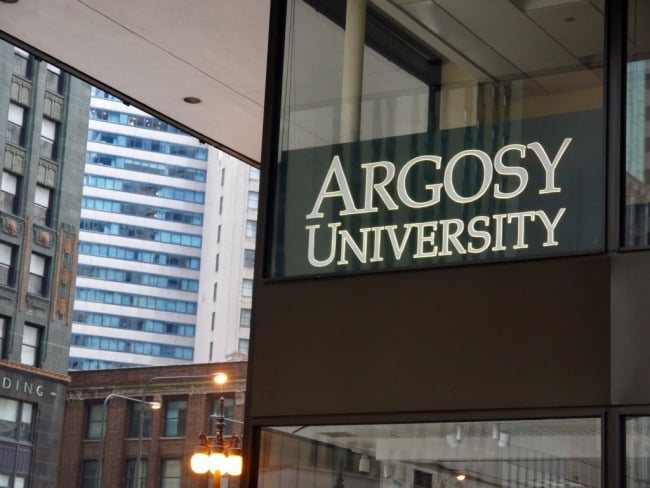You have /5 articles left.
Sign up for a free account or log in.

Argosy University's Chicago campus
Getty Images
The Dream Center, a Los Angeles nonprofit that had agreed to purchase Argosy University and the Art Institutes chain just 24 months earlier, closed its doors in March amid finger-pointing and recriminations between a court-appointed receiver, congressional Democrats and the Education Department.
The Trump administration had blasted Dream Center management in a letter days earlier that announced it was cutting off federal aid to the chain of colleges. The receiver claimed he never saw millions in missing money for financial aid payments. And Democrats accused the Trump administration of dithering as major red flags appeared and closure of campuses became inevitable.
But many observers say the collapse of the college chain was foreseeable years ago because of the nonprofit's thin financial resources combined with the troubled history of campuses previously operated by the for-profit Education Management Corp.
The Dream Center deal moved forward, however, without objections from the department or some of the more stringent conditions that had been imposed on previous major for-profit transactions. And within months of closing the deal, Dream Center found that revenues at its new campuses fell millions short of projections by EDMC, creating shortfalls the nonprofit didn't have the resources to cover. Now most of the college chain is closed after the company failed to make millions in financial aid payments to students.
While students scramble to figure out how to complete their degrees, experts on college oversight, lawyers and former department officials are asking why the Education Department didn't do more to prevent just this kind of outcome for Dream Center. The seeds of the chain's collapse, many say, were sowed when the deal was allowed to proceed two years ago without major protections for students. And those critics say the administration doesn't appear to have learned from other recent failures of for-profit chains that closed their doors with little warning to regulators or their students.
As one for-profit company after another has faced existential challenges in recent years -- driven by a combination of economy-driven enrollment declines, misconduct and government scrutiny -- corporate leaders at entities like EDMC have sought to restructure or offload their college properties. The tribulations of those entities have tested the oversight capabilities of the Education Department in new ways.
“The department absolutely can say, ‘We will not approve you for federal financial aid if you consummate this deal.’ ”
Last year, Education Corporation of America made plans to close nearly 30 campuses to shore up its finances before abruptly announcing months later that it would close its entire chain of colleges, leaving the feds and accreditors to clean up the mess and help students resolve questions over credit transfer and loan-forgiveness options. Under the Obama administration, department officials gave their blessing to a 2014 deal in which Zenith Education Group, a nonprofit owned by loan-guarantee agency ECMC, would purchase the ailing Corinthian Colleges chain, but only after imposing a number of conditions on the sale. (Zenith eventually spent more than half a billion dollars to close down all but a handful of former Corinthian campuses.)
When ITT Technical Institutes later began looking for a buyer, potential suitors -- including Dream Center -- were warned they would have to meet similar conditions. No buyer meeting those standards emerged, and department officials instead began to make plans for ITT's eventual closure. The for-profit chain eventually shut down all its campuses in 2016.
Some former department officials were surprised to see the nonprofit resurface later in connection with EDMC. And since Dream Center’s collapse, consumer advocates have questioned why the kinds of demands imposed on suitors for Corinthian and ITT weren’t required for federal approval of the EDMC sale.
The department could have limited new enrollment at Dream Center campuses as part of the deal, critics have argued, or required that the chain secure teach-out agreements -- basically an arrangement with a comparable institution or institutions to accept students into their programs should the former EDMC campuses go under.
“The problem here is that there are dozens of cumulative warning signs for almost all of these massive for-profit closures that get ignored or underplayed or sidestepped by the department,” said Clare McCann, deputy director for federal policy at New America’s education policy program. “And then they fail to take action before it’s too late.”
An Education Department spokeswoman said that criticism amounted to Monday-morning quarterbacking.
"Department officials, throughout this process, have had a singular focus: doing what's best for students," said Liz Hill, a spokeswoman for the department. "They acted on the best information they had at the time they had it."
Because of the department's work with Dream Center, she said, thousands of students at former EDMC campuses were able to finish their programs before the chain ultimately went into receivership.
Deal Scrutinized From the Beginning
The Pittsburgh-based EDMC’s sale of the Art Institutes, Argosy and South University chains was a sign of the downturn for the for-profit sector in recent years. The company, which had become one of the largest in the industry, was facing declining enrollment, lawsuits and crackdowns by regulators. The company agreed in 2015 to pay $95.5 million to settle claims of illegal recruiting after an investigation by the Department of Justice. The government found that EDMC was running a high-pressure sales business that rewarded recruiters based on the number of students enrolled and that EDMC improperly benefited from federal grants and loans.
Dream Center, though, saw operating a higher education system as a chance to further its enterprises assisting the indigent. Randall Barton, managing partner of the Dream Center Foundation, said in 2017 that the deal “aligns perfectly with our mission, which views education as a primary means of life transformation.”
Before the transaction closed in October of that year, it faced major criticism from consumer advocates, who called on Education Secretary Betsy DeVos to seek public comment and hold hearings before ruling on the deal, and confronted hurdles getting approval from accreditors. The Dream Center addressed the organization's lack of experience in higher education by bringing on Brent Richardson, former chairman of Grand Canyon University, as an adviser.
"Department officials, throughout this process, have had a singular focus: doing what's best for students. They acted on the best information they had at the time they had it."
The Education Department also imposed several conditions as part of a preacquisition review of the deal: Dream Center would be required to submit a letter of credit, to file regular financial disclosures and to submit monthly enrollment reports so the department would have up-to-date information on student rosters.
After independent auditors found major shortfalls in revenues at the former EDMC schools, Richardson and Dream Center management decided to wind down roughly 30 campuses that accounted for a large chunk of the operating losses.
But by late 2018, Dream Center began defaulting on payments owed to creditors and pursued a receivership arrangement through a federal court. Within weeks, headlines began to pile up about failures by Argosy and other Dream Center colleges to pay student aid stipends. After DCEH and its court-appointed receiver, Mark Dottore, couldn’t explain what happened to millions in missing aid payments, the Education Department took the rare step of cutting off Title IV money to the chain of campuses, all but guaranteeing their eventual closure.
Barmak Nassirian, director of federal relations and policy analysis at the American Association of State Colleges and Universities, said the situation was fairly straightforward: there was never enough money to keep the enterprise going. “This was somebody taking over what they thought would be an ATM,” he said, despite the chain being a “distressed toxic asset.”
"Of course this could have been prevented. It should have been prevented," Nassirian said.
What Happened Earlier
Hill, the department spokeswoman, said that the department didn't have the statutory or regulatory authority to block a deal in the first place. She said the department never gave preliminary approval to the deal; instead it only found no impediments for the change in ownership in a process called a preacquisition review. But Hill said an institution -- or chain of colleges, in the case of the former EDMC campuses -- keeps access to federal aid on a temporary basis until the department either issues final approval or denies a change in ownership, she said.
While the Education Department can't legally block the sale of a college, it can -- and often does -- tell a buyer that it won't keep access to federal aid if a deal goes through, said Aaron Lacey, a lawyer who advises higher education clients.
“The department absolutely can say, ‘We will not approve you for federal financial aid if you consummate this deal,’ ” Lacey said.
The department also has discretion when it comes to the conditions it imposes on new ownership in contracts to participate in federal Title IV programs. Most of the language in those contracts, known as program participation agreements, is standard boilerplate. But the Education Department can tailor requirements in the agreement to risks officials identify at the buyer or circumstances at the college. That may include requiring additional collateral through a letter of credit or caps on enrollment to limit growth.
"That's really an extraordinary amount of control," Lacey said.
Whether or not the department had the legal authority to block a deal outright, it has broad authority to impose conditions that would create a de facto denial, said Ben Miller, vice president for postsecondary education at the Center for American Progress.
"There are things you can do to make a deal essentially untenable," he said.
The basic conditions the Education Department described for the Dream Center sale appeared to closely resemble those imposed on a 2016 deal that took the formerly publicly traded University of Phoenix private, suggesting the department relied at least in part on the framework for previous for-profit deals. In the Phoenix sale, the department also asked for 13-week projected cash flow statements as well as monthly enrollment reports.
But the requirements for Dream Center appeared to be less stringent, even though Phoenix was in better financial health and didn't have EDMC's troubled history with regulators.
Department officials, for example, required a letter of credit equivalent to 25 percent of federal financial aid funding for Phoenix. They sought only a 10 percent letter of credit from Dream Center. And the department actually released funds from an existing letter of credit it held from EDMC.
Phoenix was also required to cap enrollment at existing levels until it received final approval for the sale. And it was tasked with raising its retention and graduation rates within a year of getting department approval.
"A worse set of schools with less qualified ownership in every sense got a better deal," Miller said.
Dream Center also brought fewer financial resources to the deal than had the buyers of other for-profit chains. ECMC, the loan-guarantee agency that bought Corinthian Colleges in 2014, had the deep pockets to burn through half a billion dollars winding down those campuses. Dream Center had roughly $225 million in assets when it bought the Argosy and Art Institutes chains. And its leaders reportedly were betting on the colleges generating $30 million of revenue in the first year. The nonprofit's limited resources and the rosy financial projections should have led to more scrutiny of the deal, former officials said.
“It is really up to the department to put conditions in place to mitigate the consequences of the acquirer not being able to keep the organization going," said Jay Urwitz, a former deputy general counsel at the Education Department who retired in 2017 and is now a senior fellow at the American Council on Education.
The department should have said it would take its chances on EDMC or wait for another buyer, Urwitz said.
It's not clear how the Education Department used the information it required Dream Center to report on its financials and enrollment. The Office of Federal Student Aid has reached out directly to students about the cancellation of loans issued for the spring semester. But they will likely have to apply themselves to have other loans cleared.
Miller said with the regular cash flow reports, the chain's pursuit of receivership in December "should not have been a surprise to the department."
Web of Regulators Involved in Deal
The Dream Center transaction with EDMC didn’t just require the go-ahead from federal officials; it also had to get approval from three different institutional accreditors as well as several other professional accreditors for programs like law and psychology. Argosy, which is accredited by the WASC Senior College and University Commission, was told when the deal was agreed to in 2017 "it would be a very high bar" to clear for approval due to serious governance, independence and financial issues raised by the accreditor.
Jamie Studley, the WASC president, said that in 2018 there was some progress addressing those issues but not enough to get full approval for the conversion or have its accreditation reaffirmed.
The closing of roughly 30 campuses last year, followed by the installation of a receiver and the imposition of more stringent cash restrictions by the department, signaled a serious turning point in the finances of the enterprise. WSCUC requested teach-out plans from Dream Center in December when the receivership was imminent. And it followed immediately by putting Argosy on "show cause" status on Jan. 19, requiring the chain to demonstrate why its accreditation should not be withdrawn.
“The tension in this process lies in policing whether an institution meets standards while not undercutting students’ ability to complete or transfer their programs," Studley said. "In the future, as a policy matter, I believe we will need to look at more effective ways to decouple the two.”
Some consumer advocates have said the department should have required teach-out agreements at all Dream Center institutions as a condition of the original 2017 deal rather than deferring to accreditors. In a rule-making process currently unfolding at the department, some are pushing for automatic triggers for the agreements to be written into federal regulations.
McCann of New America said the Trump administration should have at least pressed the company to make those arrangements when its financial health began to deteriorate.
"When you know a school is in a precarious financial position, an important thing to do is first and foremost get a teach-out agreement," she said. "Once those 30 campuses closed, that was yet another sign you should request those agreements."
Democratic lawmakers have called on the Education Department’s top watchdog to investigate the missing student aid payments and the Trump administration’s handling of the Dream Center deal more broadly.
In a February letter to the department’s acting inspector general, Senator Dick Durbin, an Illinois Democrat, and Representative Rosa DeLauro, a Connecticut Democrat, said the deal “raised concerns from the very beginning about the risks it posed to students and taxpayers. Those concerns have certainly been realized.”
While DeVos never gave final approval to the deal, the department also never put appropriate protections in place, the Democrats argued. After the sudden collapse of the ECA chain and Vatterott College last year, it was again caught flat-footed, resulting in more chaos for students.
The saga suggested officials appointed by DeVos haven’t learned from previous experiences managing for-profit shutdowns, said Beth Stein, vice president of the Institute for College Access and Success. More than any other change, Stein said, federal officials should have learned by now to communicate proactively to students about financial difficulties faced by their institution.
“Here we are, Argosy is essentially closed,” she said. “It’s not a surprise to me. It’s not a surprise to the department. But the students had no idea.”




